What Is Biophilic Furniture: 2025 Guide
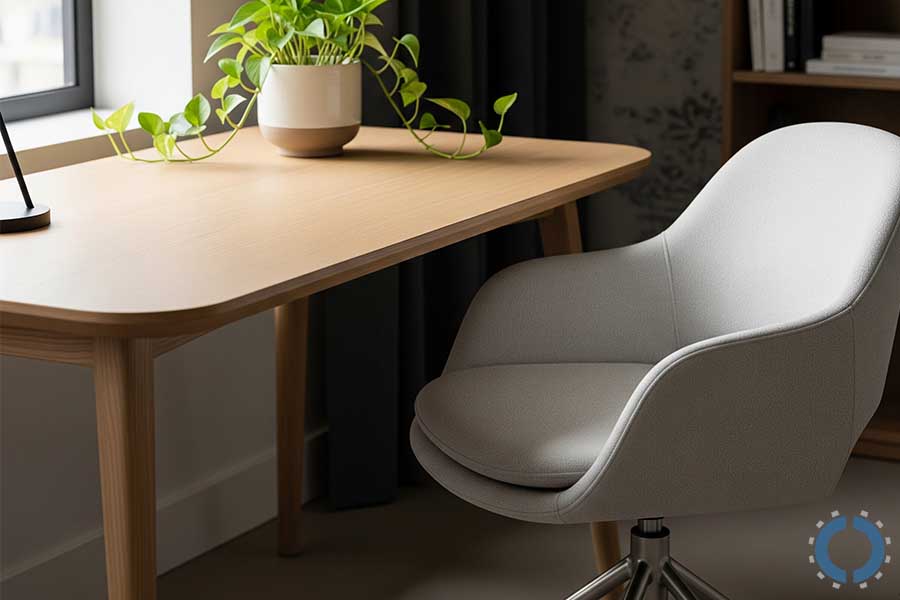
In today’s world, we are more distant from nature than ever before.
The presence of tall buildings, small apartments, and ubiquitous technology has diminished the presence of nature’s green in our living spaces.
This is where biophilic furniture becomes even more important.
Now the question is: What is biophilic furniture?
In 2025, biophilic furniture is designed to connect people with nature, utilizing sustainable materials, natural textures, organic shapes, and features such as greenery integration. It promotes well-being, reduces stress, and enhances productivity in modern workspaces.
Office furniture Houston that, by utilizing natural materials, environmentally inspired forms, and soothing colors, connects the modern world and the inherent human need to connect with nature.
In this comprehensive guide in 2025, you’ll learn what exactly biophilic furniture is, what principles go into its design, what benefits it offers for offices, and what trends and innovations will make it a top choice in 2025.
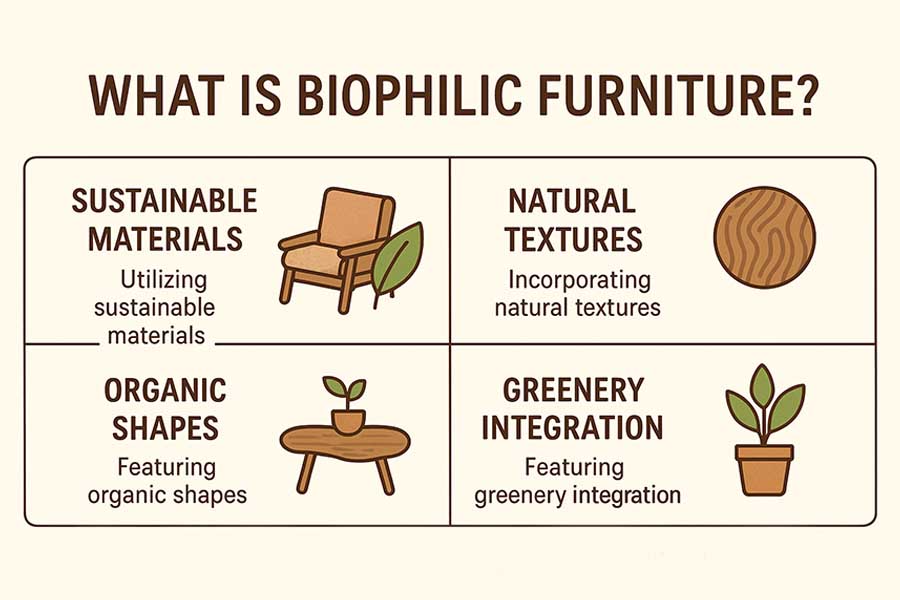
You Might Also Enjoy: Where to Buy Modern Office Furniture in Houston: 2025 Review
Origins and Concept of Biophilia
The term Biophilia was first coined by the famous American biologist Edward O. Wilson in the 1980s.
In his book Biophilia, he explained that humans have an innate and evolutionary affinity for nature.
This deep connection is part of the human essence and psyche.
Research has shown that people are more relaxed when they work in environments that are surrounded by natural elements or symbols of them.
Therefore, in such workspaces, employees experience less stress and are more creative.
In fact, our bodies and minds respond positively when we are in environments filled with signs of nature.
This is why biophilic furniture has become so important in offices in 2025.
Biophilia is a reminder that without nature, human well-being is incomplete, and biophilic furniture is one way to bring this ancient connection back into our modern lives.
Core Principles of Biophilic Furniture Design
To create biophilic furniture, elements of nature must be incorporated into its design in some way.
Below, we explore the key principles of biophilic furniture design:
- Natural materials: Biophilic furniture is made from materials that come directly from nature.
Natural-grained wood, bamboo, stone, recycled metals, and fabrics such as linen or wool are examples of these materials.
These choices both create a sense of closeness to nature for people and contribute to environmental sustainability.
- Organic forms: In nature, straight lines and perfect geometry are rarely seen.
For this reason, biophilic furniture often uses soft, curved forms inspired by natural shapes such as leaves, water waves, or tree trunks.
These forms create visual peace and greater harmony in the space.
- Nature-based colors and textures: The design of this type of furniture usually uses a range of earthy colors, soft greens, sky blue, and warm shades of nature.
Along with color, tactile textures such as raw wood surfaces, handmade fabrics, or polished stone contribute to the user’s multisensory experience.
- Living elements: One of the attractive features of biophilic furniture is its combination with living elements.
From tables with plant stands to office chairs next to green walls and even small water features, everything can be part of the design.
These elements bring the presence of nature into the interior.
- Natural light and views: Although artificial lighting plays an important role, biophilic design emphasizes maximum use of natural light.
Furniture placed next to windows or skylights, or even a design that opens to the outside and the natural landscape, enhances the sense of connection to the outdoors.
- Sustainability: Biophilia is tied to environmental responsibility.
The use of recycled materials, renewable resources, and low-energy production processes is an important principle in the design of this type of furniture.
In this way, choosing any piece of biophilic furniture means making a conscious choice for the future of the Earth.
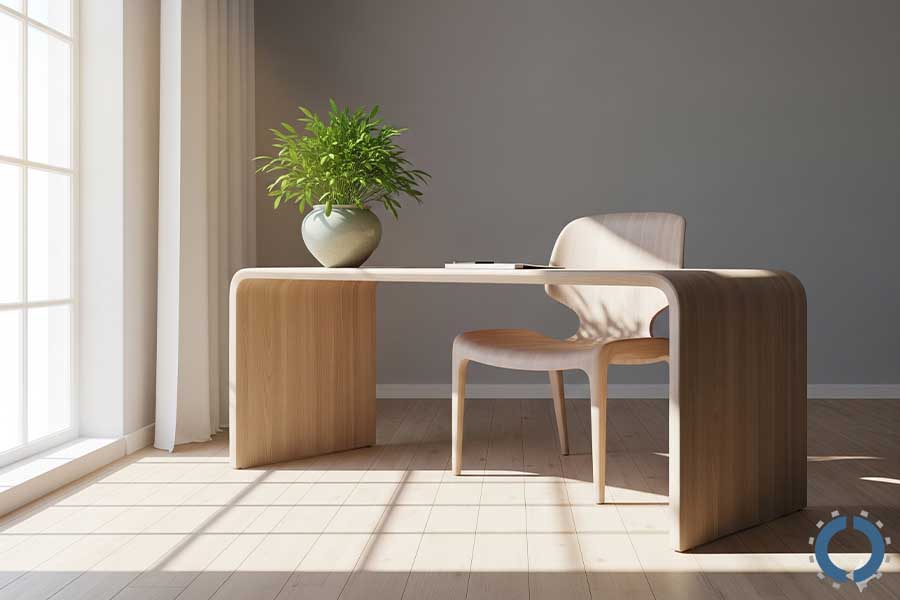
You Might Also Enjoy: How to Choose the Right Office Furniture?
Benefits of Biophilic Furniture
Biophilic furniture offers a range of benefits for health, productivity, and the overall living experience.
Below, we examine its most important achievements:
- Mental health: Research shows that the presence of natural elements in the living environment can significantly reduce stress.
Biophilic furniture, with soothing colors and textures and a close connection to nature, creates a space that improves mood, reduces anxiety, and increases creativity.
Such an environment calms the mind and creates a sense of inner security.
- Productivity and performance: Work and educational spaces designed with biophilic furniture are usually more productive.
Because when a person is in a calm, natural, and balanced environment, their mind focuses better.
This type of design helps employees and students focus more, learn faster, and increase the quality of their performance.
- Physical health: Using natural materials and even the presence of live plants in furniture can help improve the air quality in the space.
Some plants absorb pollutants and harmful particles and keep the humidity in the air balanced.
As a result, a healthier environment is created for breathing and working.
Also, using non-toxic and sustainable materials in furniture production further ensures the health of residents.
- Aesthetic value: Another great benefit of biophilic furniture is its unique beauty.
This furniture creates a rich and harmonious space that conveys the touch, smell, and even the feeling of being in nature to the user.
2025 Trends and Innovations in Biophilic Furniture
- Curved and Organic Designs: In the 2025 biophilic furniture trend, hard lines and sharp angles have gradually given way to soft, curved forms.
Inspired by leaves, water waves, or the natural forms of mountains and rocks, furniture in 2025 has taken on a more organic look that is both pleasing to the eye and more relaxing to the space.
- Multifunctional and Modular Furniture: In 2025, homes and workspaces will have become smaller, so there is a need for furniture that is flexible and multifunctional.
In addition to being made with natural materials and a design inspired by nature, biophilic furniture can be modular and mobile.
This means it can be transformed for work, relaxation, or partying, without losing its natural and warm feel.
- Technology Integration: One of the most exciting trends this year is the combination of biophilic design with smart technologies.
From smart lighting that adjusts the body’s circadian rhythm to furniture that responds to weather conditions, all serve to create a healthier, more harmonious space.
This integration shows that nature and technology can coexist, not be in conflict.
- Local Craftsmanship and Handmade Elements: In 2025, there will be more attention to authenticity than ever before.
The use of handicrafts, furniture made with traditional skills, and indigenous materials gives the space character and creates a deeper connection to the surrounding culture and environment.
This process transforms biophilic furniture from a simple product into a piece of art with soul and story.
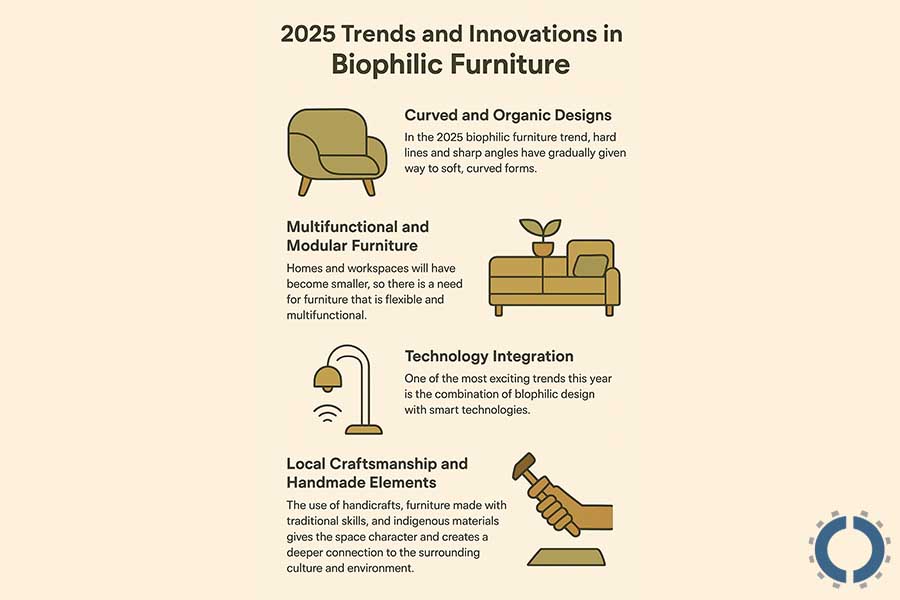
You Might Also Enjoy: How to Organize Office Furniture in 2025?
How to Incorporate Biophilic Furniture in Your Space
You don’t need to make any major changes to benefit from biophilic furniture.
Even with a few choices, you can bring a sense of nature into your home or office.
Here are some important steps and tips:
1. Assessing your current environment
First of all, check your available space.
How much natural light enters the space?
What corners or walls have the most potential for change?
Understanding the limitations and possibilities of the space makes it easier to choose biophilic furniture and elements.
2. Choosing focal pieces
Making changes to one or two pieces of furniture that have a high visual and functional impact can make a big difference.
For example, a wooden table with a natural shape, a curved chair with natural fibers, or a bookcase combined with green plants will be the focal point of the space and complement the rest of the decoration.
3. Budget-friendly options and alternatives
Biophilic furniture can be expensive, but there are also affordable options.
For example, using houseplants, natural cushions and rugs, recycled wood, or small handmade pieces can convey a sense of nature without spending a lot of money.
4. Combining colors, materials, lighting, and greenery
To create a harmonious space, use natural colors, organic materials, natural or warm lighting, and live plants.
The right combination of these elements creates a beautiful and relaxing environment.
5. Maintenance tips for long-lasting natural furniture
For biophilic furniture to last for many years, regular care is required.
Protect wood and stone from direct moisture.
Clean natural fabrics with appropriate detergents.
Maintain plants based on their water and light needs.
Periodically inspect and repair man-made and natural components.
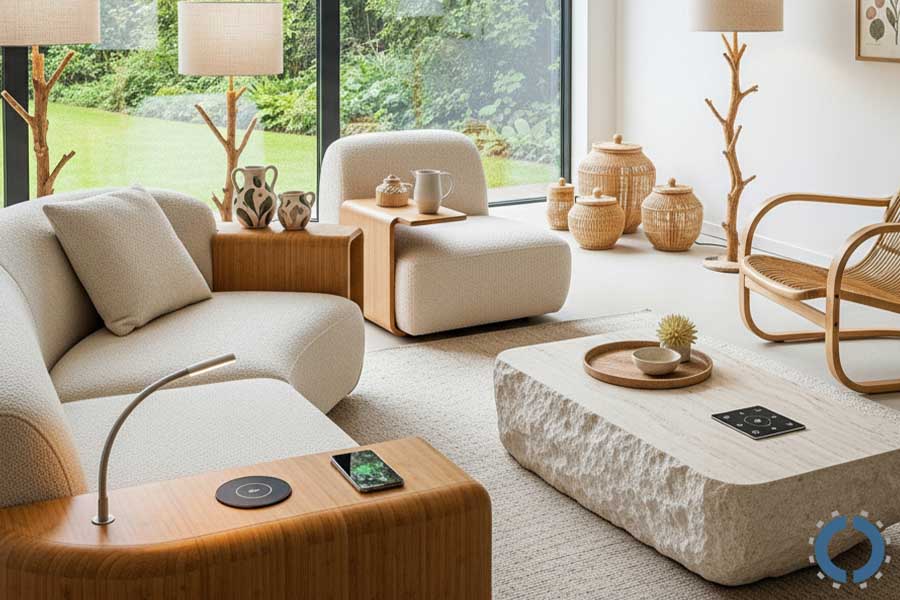
You Might Also Enjoy: Top 15 Office Furniture Every Home Office Needs
Challenges and Considerations
Although biophilic furniture has many benefits, there are a few important points to consider when designing and using it:
- Higher cost of natural or handcrafted materials: Quality woods, organic fabrics, and handmade products are usually more expensive than industrial furniture.
This can be limiting for some people or projects.
However, it is possible to strike a balance between budget and quality by choosing a mix of important biophilic pieces and other conventional furniture.
- Maintenance issues: Using live plants, bare wood, and natural fabrics requires regular care and maintenance.
Failure to do so may cause damage, discoloration, or rot.
So, before you buy, evaluate the time it will take to care for each piece.
- Balancing aesthetics with practicality: Sometimes, a very natural and artistic design may conflict with everyday functionality.
For example, a table with an attractive organic shape may have little space to place objects.
So when choosing biophilic furniture, you need to balance beauty and practicality.
- Matching biophilic furniture with different interior styles: Integrating biophilic furniture into spaces with a modern, industrial, or minimalist style can be challenging.
To solve this problem, you can use coordinating colors, textures, and details so that biophilic pieces blend naturally with other elements of the space.
Future of Biophilic Furniture
With increasing awareness of the environment and mental health, biophilic furniture has become part of the future of interior design and urban living.
Below, we examine the most important predictions and recommendations for the future of this style:
Predictions for the next decade
In the coming years, biophilic furniture is expected to be used more widely in homes, offices, and public spaces.
New, flexible, and multifunctional designs will replace traditional furniture, and the presence of nature in indoor environments will become an everyday standard.
Advancements in sustainable materials and eco-friendly production
The development of recycled materials, organic fibers, and low-consumption processes is pushing biophilic furniture production towards greater sustainability and lower environmental impact.
This trend contributes to the health of the earth and allows consumers to play a positive role in protecting the environment through their choices.
Expanding role of biophilic design in urban living
With the growth of urbanization and the reduction of direct access to nature, biophilic design will be a solution to restore human connection with nature.
Green walls and interior furnishings with living elements help maintain a sense of calm and the freshness of nature even in crowded urban environments.
Advice for designers and conscious consumers
Designers must consider creativity, sustainability, and practicality at the same time, and consumers must have an optimal and long-lasting experience of this style by choosing natural furniture, paying attention to materials, and maintaining it properly.
Biophilic furniture is an opportunity to create a healthy, beautiful environment in harmony with nature in everyday life.
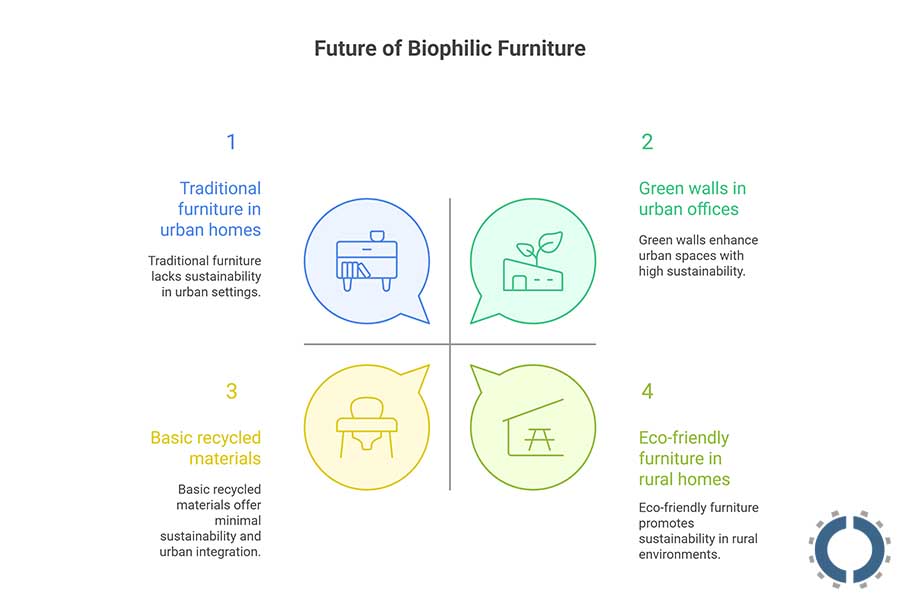
Conclusion
As we said, biophilic furniture connects humans to nature and makes the space more pleasant.
This style offers a philosophy of life and a sustainable approach to the interior environment that improves mental and physical health, increases productivity and focus, and creates a beautiful, harmonious space.
Adding a naturally shaped wooden table, a chair with organic textures, or a few houseplants can bring a sense of nature to your home or office.
Every small step is part of the path to bringing nature back into modern life!

John Ofield is the owner of Collaborative Office Interiors. Houston’s trusted source for modern and commercial office furniture, office cubicles, demountable walls, office desks and tables, and complete workspace solutions. With more than 40 years of experience, he combines deep product knowledge with hands-on space-planning expertise to create ergonomic, productivity-focused work environments for businesses across Southeast Texas.


